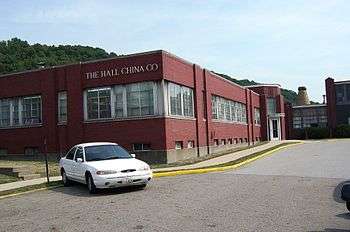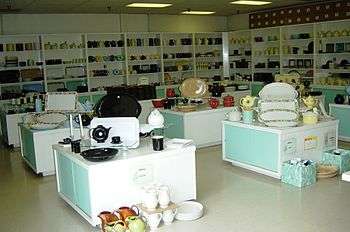The Hall China Company

Founding
The Hall China Company was founded by Robert Hall in East Liverpool, Ohio, United States in August 1903 following the dissolution of the two-year-old East Liverpool Potteries Company. He began making dinnerware and toilet seats, but soon found that institutional ware such as bedpans, chamber pots and pitchers was more profitable.
New glaze process
Robert Hall died just a year after launching the company. One of his eight children, Robert Taggart Hall, took over the company and almost immediately began developments to introduce the single-fire process, which had first been used centuries earlier by Chinese potters during their Ming Dynasty (1368-1644). His dream was to change from the two-firing manufacturing method; one firing to harden the ware and a second firing to set the glaze to the ware. With the help of staff chemists and ceramic engineers, Hall experimented from 1904 until 1911, when he and his staff came up with a glaze recipe that worked. The new process fused together the white body, color and glaze when it was fired at a temperature of 2,400 degrees Fahrenheit.
The new glazes allowed the creation of brilliant colors never before seen on American china. Hall china expert Harvey Duke lists no fewer than 47 colors developed for the new process, which allowed for rapid expansion of the company and its product selections at the onset of World War I. After tepid sales of its new housewares lines in the 1910s, the company tried designing and selling decorated teapots. Hall China became the largest producer of these products in the world. The teapot business was so successful that the company decided to expand it from the original three designs to a plethora of new shapes and colors. In the 1940s the teapot business began to dwindle. By the 1960s, probably due to the increased preference for coffee by the buying public, teapot sales had fallen to insignificance. Hall continues to be a prominent supplier of commercial restaurant dinnerware.
Jewel Tea Company association
In the mid-1920s, the directors of Hall China made a decision to associate with the Jewel Tea Company to produce an exclusive line of dinnerware for them. Jewel started using Hall teapots as premiums, and then expanded the promotion to include its own line of distinctive dinnerware and kitchenware. New pieces were introduced by Hall China for Jewel until 1980.

Other products
In the 1930s, refrigerators became more common and so, a new market was created: refrigerator-ware. Hall produced china pieces for all of the major manufacturers, including Hotpoint, General Electric, Westinghouse and Montgomery Ward. Pieces produced were pitchers, covered or not, china boxes for leftovers, butter and cheese dishes. The Hall pieces either came with the appliance or were offered as accessories to be purchased later.
During the mid-20th century, Hall China produced a number of renowned designs including the Ball and Donut jugs and the Nautilus, Donut and Aladdin teapots.
Hall China attracted talented designers, with examples being Eva Zeisel's popular "Century" dinnerware and the even more popular "Tomorrow's Classic" dinnerware and "Zeisel" tri-color lines and Donald Schreckengost's cookie jars shaped like owls, casserole dishes shaped like ducks, and teapots shaped like Ronald Reagan and Sherlock Holmes.
Manufacture process
The manufacture of Hall China begins with a mixture of quartz, feldspar and several different clays. These ingredients are mixed together with water to form a slip. The filtered slip is then pumped into presses to remove the water and leaving filter cakes.
The cakes are processed through a pug to remove air, before being shaped by jiggering or jolleying to produce plates and bowls. For items such as teapots, the cakes have water added to them and the resulting slip is poured into moulds and moved through the glazing and firing processes. When completed, the pieces are decorated by hand-painting, decals or printing.[1]
Current status
Hall China continues in production today. The company has reissued many of its earlier designs, including some that had previously been considered rare, such as the Airflow and Rhythm teapots, the Donut and Streamline jugs, and some of the water servers from the refrigerator-ware lines. To allay concerns from collectors, the reissued products are marked differently and use different colors.
Hall China celebrated its 100th birthday in 2003 with the publication of A Centennial History of the Hall China Company by Catherine S. Vodrey. In 2010 Homer Laughlin China Company purchased Hall China.[2]

Notes
- ↑ Margaret and Kenn Whitmyer (1994). The Collectors Encyclopedia of Hall China. Schroeder Publishing Co, Inc. p. 13. ISBN 0-89145-581-7.
- ↑ Manufacturing.net http://www.manufacturing.net/news/2010/03/homer-laughlin-hall-china-to-merge. Retrieved 25 June 2015. Missing or empty
|title=(help)
References
- Margaret and Kenn Whitmyer, The Collectors Encyclopedia of Hall China, Schroeder Publishing Co, Inc., 1994